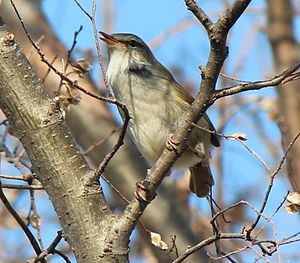Japanese Bush Warbler
| Japanese Bush Warbler | ||||||||||||
|---|---|---|---|---|---|---|---|---|---|---|---|---|

Japanese Bush Warbler ( Horornis diphone ) |
||||||||||||
| Systematics | ||||||||||||
|
||||||||||||
| Scientific name | ||||||||||||
| Horornis diphone | ||||||||||||
| ( Kittlitz , 1830) |
The Japanese bush warbler ( Horornis diphone , Japanese 鴬 uguisu ), also known as the Japanese nightingale or Uguisu , is a songbird that you hear more often than you see. His characteristic courtship call, Japanese Hōhokekyo , can be heard in many places in Japan at the beginning of spring. The beauty of its singing has given it the name Japanese Nightingale , but unlike its European counterpart, it sings during the day.
Appearance
The Japanese bush singer's plumage is gray-brown and he is very shy. Usually it can only be seen in the spring, before the trees get their foliage. The males of this species are about 16 centimeters tall, the females about 14 centimeters.
Occurrence
The Japanese bush warbler occurs in East Asia, the Japanese island chain and the Philippines. There this species inhabits the grasslands, the mountain groves and the undergrowth of the forests.
Way of life
The Japanese bush warbler searches for insects in the undergrowth of light forests in the tall grass. In autumn the birds move to their winter quarters in southeast China.
Reproduction
Both partners build the 10–13 cm high nest together in bushes or in tall grass. It consists of smaller twigs that are intertwined with leaves and twigs. The female lays 4–5 eggs in the up to 9 cm deep hollow of the nest. The young hatch after 13-14 days. Both adult birds take over the breeding business and the care of the nestlings. Mainly insect larvae and smaller flies are fed.
song
The song of the Japanese nightingale is one of the most popular motifs in Japanese poetry and appears in many poems from collections such as the Manyōshū and the Kokinshu . In Haiku and Renga , the nightingale is one of the seasonal words ( kigo ) for the beginning of spring. It is also associated with the plum blossom ( ume ) and is shown together with it on the Hanafuda cards. But the song of the nightingale can only be heard in Japan in late spring, after the plum blossoms have wilted.
In winter the bird sings another song and is then referred to in the haiku by the name Sasako , the song is called sasanaki .
The Japanese bush warbler is one of the "three famous songbirds" of Japan, alongside the Japanese flycatcher and the Japanese robin ( Erithacus akahige ).
The Japanese bush singer's excrement has long been used as a skin lightener and for wrinkle removal. It was also used to remove stains from kimonos . Even today you can sometimes buy the so-called "Uguisu powder".
The " nightingale floor " ( uguisubari ) in Japanese castles is named after the Japanese nightingale , where every threshold causes a characteristic chirping sound when stepping on it. This form of the "alarm system" can be found, for example, in Nijō-jō , Eikan-do and Chion-in in Kyoto .
Audio files
- : Pi pi pi ... kekyo kekyo Hooo- hoke'kyo Hoohokekyo.
- : Hooo-hokekyo, hooo-hokekyo. The songs of two Japanese nightingales in one file
- : Hoohokekyo
- : Hoohokekyo
- : Hoohokekyo
Danger
Since this species is still relatively common and there are no known hazards, it and the IUCN are listed as ( Least Concern ) not endangered.
Subspecies
There are five known subspecies:
- Horornis diphone riukiuensis Kuroda , 1925 - occurs in southern Sakhalin and the southern part of the Kuril Islands .
- Horornis diphone cantans ( Temminck & Schlegel , 1847) - occurs in the central and southern parts of Japan and the north of the Ryūkyū Islands .
- Horornis diphone restrictus Kuroda , 1923 - is widespread on the Daitō Islands and possibly the southern part of the Ryūkyū Islands.
- Horornis diphone diphone ( Kittlitz , 1830) - occurs on the Izu Islands , the Bonin Islands and Kazan-rettō .
- Horornis diphone canturians ( Swinhoe , 1860) - is common in central eastern China.
literature
- Jiří Felix (eds.), Květoslav Hísek: Asian fauna in color. Translated from the Czech by Ingeborg Šestáková. Karl Müller Verlag, Erlangen 1989, pp. 172-173.
Web links
- Horornis diphone inthe IUCN 2017 Red List of Threatened Species . Posted by: BirdLife International, 2016. Retrieved December 14, 2017.
- Image of a Japanese Bush Warbler
- Recordings of call
- Videos, photos, and sound recordings for Japanese Bush-warbler ( Horornis diphone ) in the Internet Bird Collection
Individual evidence
- ↑ World Bird List Wren-babblers, crombecs, bush warblers, Streaked Scrub Warbler, yellow flycatchers & hylias ( page no longer available , search in web archives ) Info: The link was automatically marked as broken. Please check the link according to the instructions and then remove this notice.